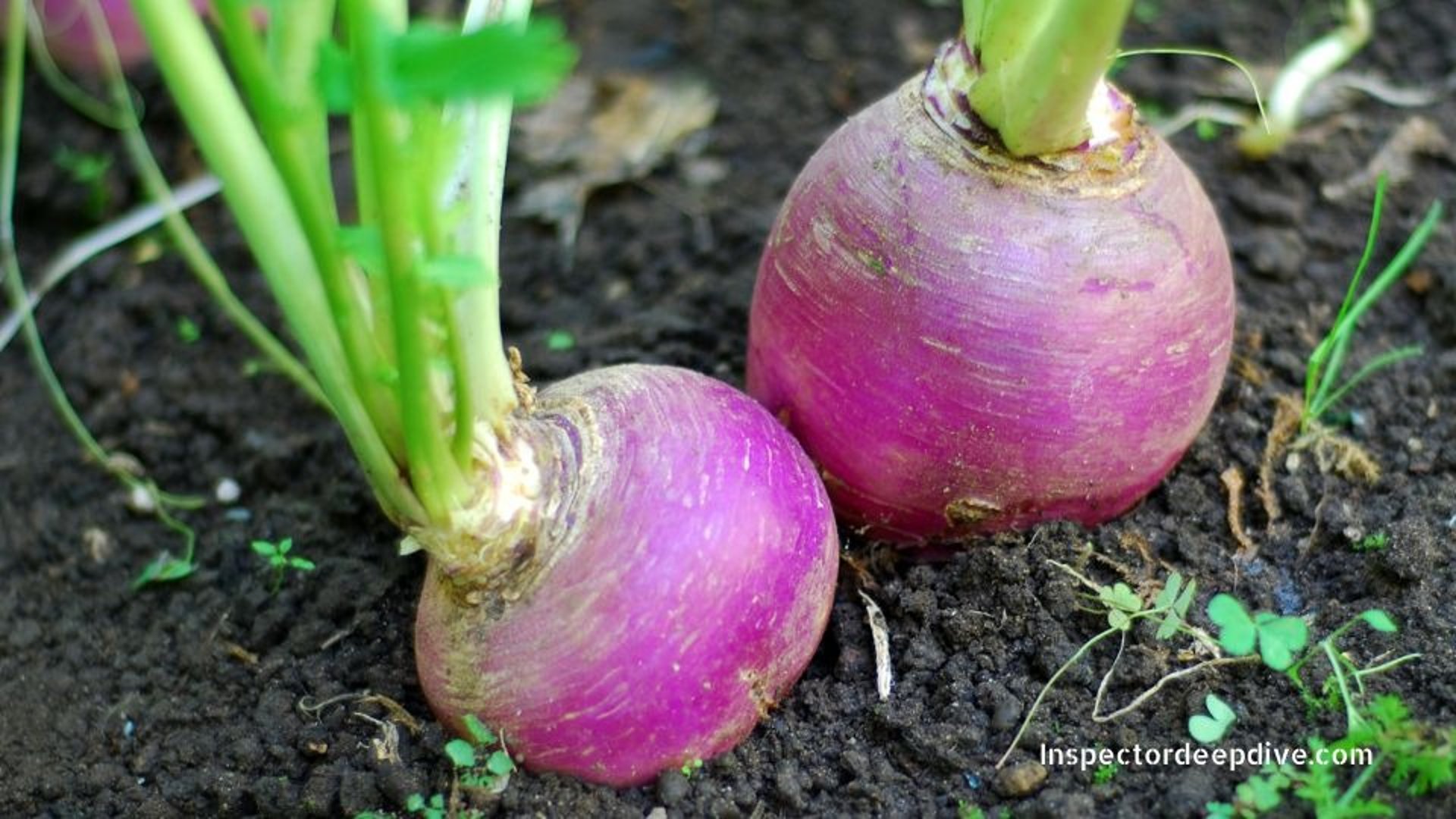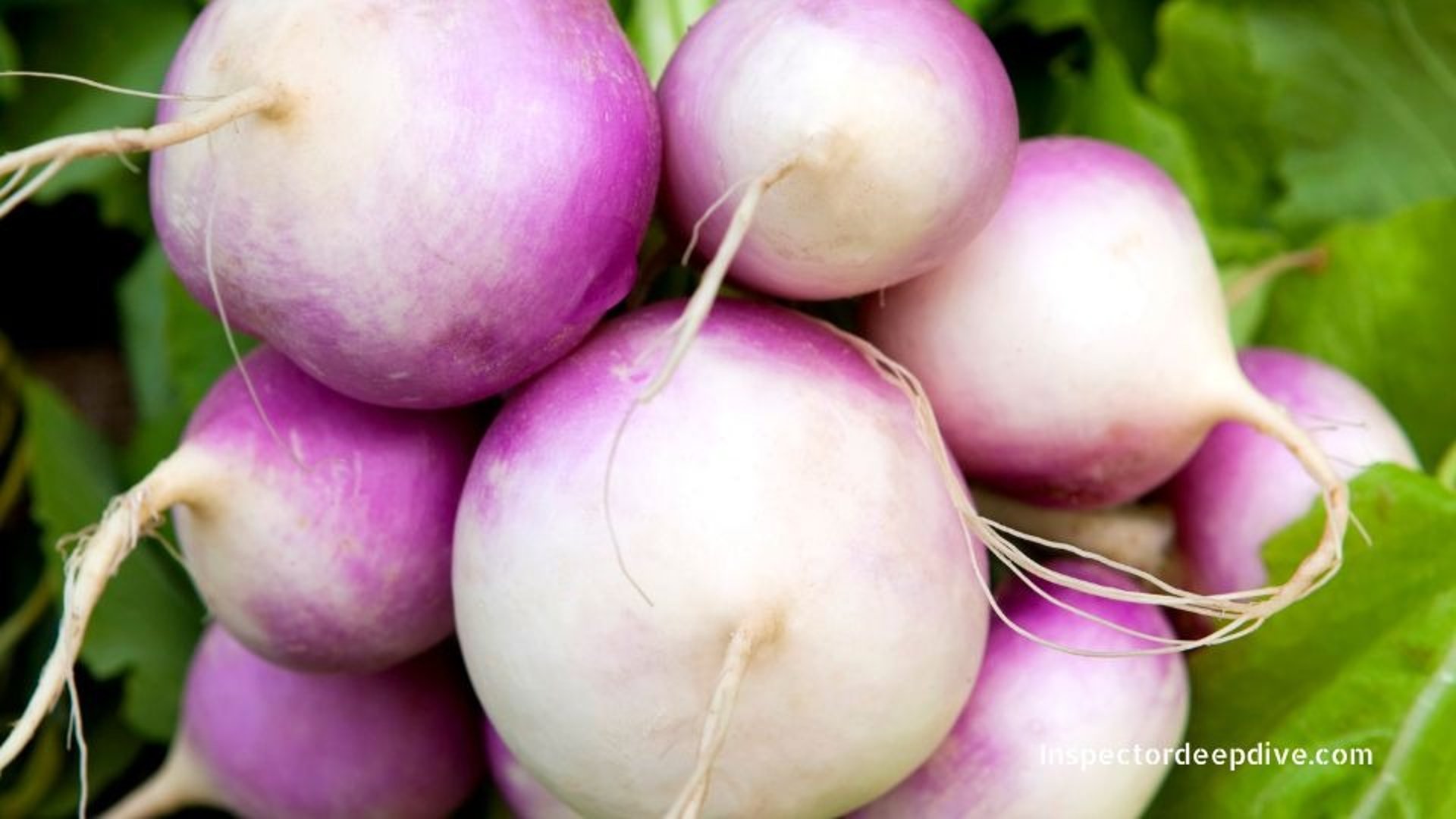
Turnip Health Benefits: Digestion, Bones & Immune Support

Turnip Health Benefits: Digestion, Bones & Immune Support
Scientific Name: Brassica rapa
Family: Brassicaceae Cruciferous family
What is turnip?
Turnip is a root vegetable characterized by its bulbous taproot and edible leafy greens. It belongs to the cruciferous family, alongside broccoli and cabbage. Raw turnips have a slightly peppery or bitter taste, which mellows and sweetens significantly upon cooking.
Where does it come from?
Origin: Europe and Asia, cultivated for thousands of years as a staple food.
Today: Grown worldwide, particularly in temperate climates.
How many varieties?
There are several varieties of turnips, including:
Purple-top White Globe: The most common, with a white base and purple top.
Golden Ball: Yellow-fleshed with a milder, sweeter flavor.
Hakurei (Tokyo Turnip): Small, white, and very tender, often eaten raw.
Other varieties vary in size, color, and sweetness.
Seasonality & availability
Turnips thrive in cool weather and are most abundant during fall and winter. They are widely available year-round due to global farming practices.
Key benefits
Digestive health: High fiber content supports healthy digestion and regularity.
Bone health: Provides vitamin K and calcium, essential for strong bones.
Immune function: Rich in vitamin C and antioxidants, boosting the immune system.
Weight management: Low-calorie density and high nutrient profile make it a good choice for healthy eating.
Blood pressure regulation: Potassium content helps maintain healthy blood pressure levels.
The Anti-Factor
Anti-inflammatory: Contains glucosinolates and antioxidants that help reduce inflammation throughout the body.
Antioxidant: Neutralizes free radicals, protecting cells from oxidative stress and damage.
Anti-cancer: Glucosinolates break down into compounds (e.g., isothiocyanates) that may reduce the risk of certain cancers, particularly colorectal cancer.
Anti-aging: Vitamins A and C promote skin health and reduce signs of aging.
Anti-diabetic: Low glycemic index and fiber content help regulate blood sugar levels.
Nutritional breakdown (per 100 g cooked)
Vitamins
Vitamin C: 12 mg, boosts immunity and aids collagen production
Vitamin K: 120 µg, supports blood clotting and bone health
Vitamin B6: 0.1 mg, supports brain health and metabolism
Folate: 12 µg, assists in cell division and pregnancy health
Vitamin A: 1 µg, supports vision and immune function
Minerals
Calcium: 28 mg, supports bone health and muscle function
Iron: 0.3 mg, helps transport oxygen in the blood
Magnesium: 9 mg, involved in energy production and muscle relaxation
Potassium: 190 mg, regulates fluid balance and supports heart health
Zinc: 0.2 mg, supports immune function and wound healing
Macronutrients
Water: 88 g, keeps you hydrated and supports cellular function
Energy: 22 kcal, low-calorie option for light meals or snacks
Protein: 1 g, provides essential amino acids
Total fat: 0 g, extremely low in fat
Carbohydrates: 4 g, includes natural sugars and dietary fiber
Fiber: 2 g, promotes digestive health and satiety
Sugars: 0 g, naturally occurring (trace amounts rounded)
Risks
Digestive discomfort: High fiber content and sulfur-containing compounds may cause bloating or gas in sensitive individuals, especially when consumed raw in large quantities.
Goitrogens: Like other cruciferous vegetables, turnips contain goitrogenic compounds that can interfere with thyroid function if consumed in very large amounts by individuals with iodine deficiency or pre-existing thyroid conditions.
How it affects your body
Hydration: High water content contributes to overall hydration.
Digestion: Fiber content aids digestion and feeds beneficial gut bacteria.
Inflammation & oxidative stress: Antioxidants and glucosinolates reduce inflammation and protect cells.
Bone strength: Vitamin K and calcium support bone density.
Medication or supplement interactions
Blood Thinners: High vitamin K content may interact with blood-thinning medications like warfarin. Consult a doctor if taking such medications.
Thyroid Medications: Individuals with thyroid conditions should consume turnips in moderation, as goitrogenic compounds may affect thyroid function.
Who should be cautious?
Individuals on blood thinners, those with thyroid conditions, or people on low-potassium diets should monitor their intake and consult a healthcare professional. Those prone to digestive issues may find cooked turnips easier to digest.
Surprising truths
Nutrient-dense greens: Turnip greens are often more nutrient-dense than the root itself, rich in vitamins A, C, and K.
Ancient staple: Turnips were one of the first domesticated crops and were historically used as animal feed before becoming a human staple.
Cruciferous family: They are part of the same family as broccoli, cabbage, and kale, sharing many similar health benefits.
Environmental impact
Turnips are considered an environmentally friendly crop due to their minimal water requirements and relatively quick growth cycle. Sustainable farming practices help prevent soil depletion.
Chef or culinary tips
Selection: Choose firm turnips with smooth skin and vibrant, fresh greens (if attached).
Storage: Store turnips in the refrigerator to extend shelf life.
Preparation: Peel the skin before cooking for a milder flavor, especially for larger, older turnips.
Cooking: Roasting brings out their natural sweetness and mellows bitterness.
Best ways to use it
Roasted or mashed: Excellent as a simple side dish.
Soups and stews: Adds a subtle flavor and nutrient boost.
Raw: Thinly sliced in salads or as a crunchy snack.
Turnip greens: Sautéed with garlic and olive oil, or added to stir-fries.
Storage & shelf life
Store turnips in the crisper drawer of the refrigerator. Properly stored, they can last up to two weeks. Cooked turnips should be refrigerated and consumed within 3–4 days.
Best time to eat
Turnips can be enjoyed at any time of day. Raw slices with hummus make a refreshing snack, while roasted or mashed turnips are great for meals.
Label reading tips
Look for fresh turnips that are firm and free of soft spots, cracks, or blemishes. Choose organic options if available to reduce pesticide exposure.
Recipes or meal ideas
Roasted Turnips: Toss with olive oil, salt, pepper, and herbs, then roast until tender.
Turnip Mash: Boil cubes until tender, then mash with butter and herbs for a healthier alternative to potatoes.
Turnip Soup: Blend cooked turnips with vegetable broth and spices for a creamy, comforting soup.
Stuffed Turnips: Halve turnips, scoop out the center, fill with a savory mixture (e.g., quinoa, vegetables), and bake.
Sautéed Turnip Greens: Sauté with garlic, lemon juice, and olive oil for a quick and nutritious side dish.
Science behind it
Turnips contain glucosinolates, which are sulfur-containing compounds that break down into bioactive isothiocyanates. These compounds are responsible for many of the anti-inflammatory, antioxidant, and anti-cancer properties. Their fiber content supports gut health, while vitamins and minerals contribute to overall cellular function and wellness.
Frequently Asked Questions
Are turnips a root vegetable or a tuber? Turnips are classified as root vegetables, specifically taproots.
Can I eat turnip greens? Yes, turnip greens are highly nutritious and can be eaten raw or cooked.
Why are my turnips bitter? Bitterness is caused by sulfur-containing compounds, which can intensify if the turnips are overripe, improperly stored, or grown in stressful conditions. Cooking often mellows this bitterness.
info@inspectordeepdive.com
© 2025 food.InspectorDeepDive.com. All rights reserved. Content may not be copied or republished without permission.
This article is for informational purposes only. InspectorDeepDive.com does not provide medical advice. Always consult a licensed healthcare provider before making dietary or health decisions.
